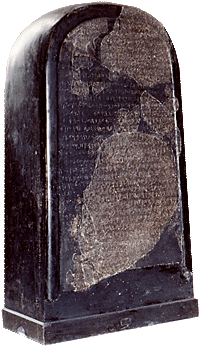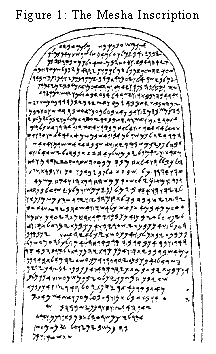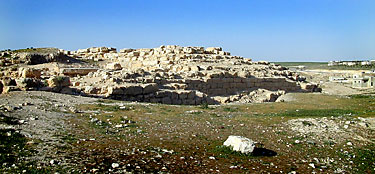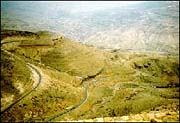What does the Moabite Stone reveal about the Biblical revolt of Mesha?

“I am Mesha, son Chemosh[it], king of Moab, the Dibonite.”[1]
So begins one of the most extraordinary ancient documents ever found. (For the unusual circumstances surrounding its discovery, see Archaeology and Biblical Research, Winter 1991: 2-3). Mesha was ruler of the small kingdom of Moab, east of the Dead Sea, in the mid-ninth century BC. He was a contemporary of Jehoshaphat, king of the southern kingdom of Judah (870-848 BC), and Joram, king of the northern kingdom of Israel (852-841 BC). Everything we know about Mesha from the Bible is recorded in 2 Kings 3. But we know a lot more about him from a record he left us, referred to as the Mesha Inscription, or Moabite Stone. It was discovered in Dhiban, Jordan, in 1868 by a French Anglican medical missionary by the name of F.A. Klein.

Both documents, 2 Kings 3 and the Mesha Inscription, describe the same event, the revolt of Mesha, but from entirely different perspectives. Mesha made his record of the event on a stone slab, or stela, 3 ft. high and 2 ft. wide. Unfortunately, the stone was broken into pieces by the local Bedouin before it could be acquired by the authorities. About two-thirds of the pieces were recovered and those, along with an impression made before the stela was destroyed, allowed all but the last line to be reconstructed. There are a total of 34 lines, written in Moabite, a language almost identical to Hebrew. It is the longest monumental inscription yet found in Palestine.
The heartland of Moab was the territory east of the southern half of the Dead Sea, from the great Arnon Gorge in the north to the Zered River in the south. North of the Arnon River, to about the northern end of the Dead Sea, was a disputed area called the “land of Medeba” in the Mesha Inscription (line 8). Medeba was a major city in the region some 18 mi. north of the Arnon. The area was sometimes under the control of Moab, sometimes under the control of others. At the time of the Conquest at the end of the 15th century BC, the region was occupied by the Amorites, who had earlier taken it from the Moabites (Num. 21:26). The Israelites then captured the area (Num. 21:24; Dt. 2:24, 36; 3:8, 16), with the tribe of Reuben taking possession (Jos. 13:16). The area seesawed back and forth for the next several centuries, passing to the Moabites (Jgs. 3:12), Israelites (Jgs. 3:30), Ammonites (Jgs. 11:13, 32-33), and back to Israel (Jgs. 11:32-33).
In the mid-ninth century BC, Mesha was successful in throwing off the yoke of Israel and bringing the area once again under the authority of Moab (1 Kgs. 3:5; Mesha Inscription).
2 Kings 3 recounts how Joram, Jehoshaphat, and the king of Edom combined forces to attempt to bring Moab back under Israelite control. They attacked from the south and were successful in routing the Moabite forces and destroying many towns (2 Kgs. 3: 24-25). But when the coalition tried to dislodge Mesha from Kir Hareseth (modern Kerak), they were unsuccessful. After Mesha sacrificed his oldest son on the ramparts of the city,
“the fury against Israel was great; they withdrew and returned to their own land” (2 Kgs. 3: 27).
The campaign must have taken place between 848 and 841 BC, the only time when Joram and Jehoshaphat were both on the throne. Although the campaign met with some success, it appears that Moab retained its independence. This is confirmed by the Mesha Inscription.
The Mesha Inscription gives us “the rest of the story.” It reads, in fact, like a chapter from the Old Testament. Its language, terminology and phraseology are exactly the same as what we find in the Bible. Mesha credits his successful revolt and recapture of Moabite territory, as well as other accomplishments, to Chemosh, national god of Moab. He does not, of course, record his defeat in the south at the hands of the coalition armies. Similarly, although the Bible records Mesha's revolt, it gives no details on his successes. So each record, accurate in its own way, records events from a different perspective.
Chronology of the Revolt of Mesha
The main problem in correlating the Mesha Inscription with the Bible has to do with synchronizing the chronology of the two sources. 2 Kings 3:5 (cf. 1:1) simply states,
“But after Ahab died, the king of Moab rebelled against the king of Israel.”
Ahab, father of Joram, died in ca. 853 BC, so Mesha's revolt must have taken place some time after 853 BC. According to the Mesha Inscription,
Omri had taken possession of the land of Medeba. And he dwelt in it in his days and half [2] the days of his son [3]: 40 years; but Chemosh restored it in my days (lines 7-9).
The Mesha Inscription not only mentions Mesha, king of Moab, known in the Bible, but also Omri, one of the most powerful kings of the Northern Kingdom (1 Kgs. 16:21-28), who ruled 885-873 BC.
Omri established a dynasty which lasted until his grandson Joram was assassinated by Jehu in 841 BC. The term “son” in the inscription simply means descendent, as we know from the Bible and other ancient Near Eastern texts. Adding the years of Omri (12, 1 Kgs. 16:23), the years of his son Ahab (22, 1 Kgs. 16:29), the years of Ahab's son Ahaziah (2, 1 Kgs. 22:52) and half the years of Joram, brother of Ahaziah, (6, 2 Kgs. 3:1), we obtain a span of 42 years. Some of the reigns of these kings could be common years, making the true span 40 years, or, the 40 year figure simply could be a round number. Thiele gives absolute years for the period from the beginning of the reign of Omri to the sixth year of Joram as 885 to 846 BC, or 40 years (1983: 217). Thus, it appears that Mesha revolted in the sixth year of Joram, ca. 846 BC. The Bible indicates that the retaliation by Joram recorded in 2 Kings 3 took place immediately upon Mesha's revolt (verses 5-7), or 846 BC. This date falls within the time period of 848-841 BC when both Joram and Jehoshaphat were ruling.
The Gods of Israel and Moab
In describing his victories over Israel, Mesha tells of defeating the town of Nebo. Among the spoils he acquired were the “altar-hearths? of Yahweh” (lines 17-18). This is the earliest mention of Yahweh, God of the Israelites, outside the Bible.
The Bible records the names of many deities worshipped by the nations around Israel. One of those gods is Chemosh. He is mentioned eight times in the Old Testament (Num. 21:29; Jgs. 11:24; 1 Kgs. 11:7, 33; 2 Kgs. 23:13; Jer. 48:7, 13, 46), always (with the exception of Jgs. 11:24) as the national god of the Moabites. The Mesha Inscription verifies that this indeed was the case. Chemosh is mentioned some 11 times in the inscription:
Mesha made a high place for Chemosh, since Chemosh gave Mesha victory over his enemies (line 3)
Because Chemosh was angry with Moab, Omri oppressed Moab (line 5)
Chemosh gave Moab back her territory (line 9)
Mesha slew the people of Ataroth to satisfy Chemosh (lines 11-12)
Mesha dragged the altar-hearth(?) of Ataroth before Chemosh (lines 12-13)
Chemosh directed Mesha to attack the town of Nebo (line 14)
Mesha devoted the inhabitants of Nebo to Chemosh (line 17)
The altar-hearths(?) of Yahweh from Nebo were dragged before Chemosh (lines 17-18)
Chemosh drove the king of Israel out of Jahaz (lines 18-19)
Chemosh directed Mesha to fight against Horanaim (line 32)
Chemosh gave Mesha victory over Horanaim (line 33)
The Cities of Northern Moab
Most of the inscription is taken up with Mesha's success in regaining the land of Medeba, the disputed territory north of the Arnon Gorge. He claims to have added 100 towns to his territory by means of his faithful army from Dibon:
[And] the men of Dibon were fitted out for war because all Dibon was obedient. And I ruled [over a] hundred of towns that I added to the land (lines 28-29).
Some 12 towns in the land of Medeba are mentioned, all of them known from the Old Testament.
“I am Mesha …the Dibonite” (line 1)
Later on in the inscription he says,
I built Qeriho: the wall of the parkland and the wall of the acropolis; and I built its gates, and I built its towers; and I built the king's house; and I made banks for the water reservoir inside the town; and there was no cistern inside the town, in Qeriho, and I said to all the people: “Make yourself each a cistern in his house”; and I dug the ditches for Qeriho with prisoners of Israel (lines 21-26).
Since Mesha erected his stela to honor Chemosh in “this high place for Chemosh in Qeriho,” and since the stela was found at Dhiban, identified as ancient Dibon, most scholars believe that Qeriho was the name of the royal citadel at Dibon. Note that Israelite captives were used to cut the timber used to construct Qeriho.
Dibon was captured from the Amorites by Israel (Num. 21:21-25, 31) and assigned to the tribe of Reuben (Jos. 13:17). But evidently it was reassigned to the tribe of Gad, since Gad built the city (Num. 32:34) and it was called “Dibon of Gad”; (Num. 33:45, 46).

The site of Dhiban and was excavated 1950-1956 and 1965. A city wall and gateway were found, as well as a large podium which the excavators believe supported the royal quarter constructed by Mesha. In addition, a text from around the time of Mesha was found which refers to the “temple of Che[mosh],” and nearly 100 cisterns were found on the site and in the surrounding area, possibly made in response to Mesha's directive to “make yourself each a cistern in his house” (lines 24- 25).
In his prophecy against Moab, Isaiah states, “Dibon goes up to its temple, to its high places to weep” (15:2, NIV). Jeremiah predicted that the fortified cities of Dibon would be ruined (48:18; cf. 48:21-22).
“And I built Baal Meon, and made a reservoir in it” (line 9)
Baal Meon was allotted to the Reubenites (Jos. 13:17, where it is called Beth Baal Meon), and built by them (Num. 32:38). An eighth century BC ostracon [an inscribed potsherd] from Samaria (no. 27) contains a reference to “Baala the Baalmeonite.” Jeremiah predicted that the judgment of God would come upon the city (48:23, where it is called Beth Meon). Ezekiel said God would expose the flank of Moab, beginning with its frontier towns, including Baal Meon (25:9). It is thought to be located at Kh. Ma'in, 5 mi southwest of modern Madaba, which has not been excavated.
Toward the end of the inscription, Baal Meon is mentioned again when Mesha records,
“And I built… the temple of Baal Meon; and I established there […] the sheep of the land” (lines 29-31).
The reference to sheep is significant, as it reflects the main occupation of the people of Moab, in agreement with the Bible. 2 Kings 3:4 tells us,
Now Mesha king of Moab raised sheep, and he had to supply the king of Israel with 100,000 lambs and with the wool of 100,000 rams.
“And I built Kiriathaim” (lines 9-10)
Kiriathaim was another city allotted to the Reubenites and built by them (Jos. 13:19; Num. 32:37). Jeremiah predicted that the city would be disgraced and captured (48:1), and Ezekiel said God would expose the flank of Moab, beginning with its frontier towns, including Kiriathaim (25:9). It is possibly located at al Qureiye, 6 mi. northwest of Madaba.
“And the men of Gad had dwelt in the land of Ataroth from of old” (line 10)Mesha devoted 3 lines of his memorial to a description of his operation against Ataroth. Although mentioned only twice in the Old Testament, the city seems to have been an important place. The name means “crowns” and was said by the Reubenites and Gadites to be a good place for livestock (Num. 32:3-4). The Gadites built up Ataroth as a fortified city, and built pens there for their flocks (Num. 32:34-36). This agrees with Mesha's inscription which says that the men of Gad had lived there “from of old.” Ataroth is most likely located at Kh. 'Attarus, unexcavated, 8 mi. northwest of Dhiban.
The entire section dealing with Ataroth reads as follows:
And the men of Gad had dwelt in the land of Ataroth from of old, and the king of Israel built Ataroth for himself, but I fought against the town and took it, and I slew all the people: the town belonged to Chemosh and to Moab. And I brought thence the altar-hearth of his Beloved, and I dragged it before Chemosh in Kerioth/my town. And I settled in it the men of Sharon and the men of Maharath (lines 10-14).
“And I brought thence the altar-hearth of his Beloved, and I dragged it before Chemosh in Kerioth/my town” (lines 12-13)
Kerioth was judged by God (Jer. 48:24), with the town being captured and its strongholds taken (Jer. 48:41). Its location is uncertain. If “my town” is the correct reading in line 13, then the text refers to Dibon, Mesha's capital.
“And Chemosh said to me: ‘Go! Take Nebo against Israel’” (line 14)
Mesha's assault of Nebo is detailed in 4 lines, the most of any of the cities mentioned in the stela. Nebo is mentioned seven times in the Old Testament, being one of the cities built by the tribe of Reuben (Num. 32:38). In his prophecy against Moab, Isaiah wrote that Moab would wail over Nebo (15:2, NIV). Similarly, Jeremiah said that judgment would come upon her, and she would be laid waste (48:1, 22).
Mesha's nighttime foray against Nebo is reported as follows:
And Chemosh said to me: “Go! Take Nebo against Israel.” And I went by night and fought against it from break of dawn till noon. And I took it and slew all: 7,000 men, boys, women, girls, and pregnant women, because I had devoted it to Ashtar-Chemosh. And I took thence the altar-hearths of YHWH and I dragged them before Chemosh (lines 14-18).
It appears that there was a worship center for Yahweh at Nebo since among the spoils were “altar hearths(?) of Yahweh.” It is perhaps for this reason that Mesha devoted the inhabitants to his god(s) Ashtar-Chemosh. The word used for “devoted” is the same as the Hebrew word harem used in the Old Testament for offering a city completely to Yahweh, such as Jericho (Jos. 6:17, 21). Nebo is most likely Kh. al Muhaiyat, northwest of Madaba and just south of Mt. Nebo.
“And the king of Israel had built Jahaz” (lines 18-19)
Jahaz is the town where the Israelites fought and defeated Sihon and his Amorite army as they first approached the promised land (Num. 21:21-31; Dt. 2:31-36; Jgs. 11:19-22). It was included in the Reubenite allotment (Jos. 13:18), and later transferred to the Levites (Jos. 21:36; 1 Chr. 6:78). Jeremiah predicted doom for the city as part of God's judgment against Moab (48:21, 34). Mesha goes on to say,
And the king of Israel had built Jahaz, and dwelt therein while he fought against me; but Chemosh drove him out from before me, and I took from Moab 200 men, all the chiefs thereof, and I established them in Jahaz; and I took it to add it to Dibon (lines 18-21).
Here, Mesha refers to a northern campaign by the king of Israel which is not recorded in the Old Testament. In order to achieve victory, Mesha had to marshal the best of his forces, 200 chiefs. Once captured, Jahaz became a daughter city of Dibon. The location of Jahaz is uncertain, although Kh. Medeineyeh 10 mi southeast of Madaba is a likely candidate.
“I built Aroer, and made the highway through the Arnon” (line 26)
The name Aroer means “crest of a mountain,” and that certainly describes this site. It was a border fortress located at Kh. 'Ara'ir on the northern rim of the Arnon river gorge. Three seasons of excavation were carried out there between 1964 and 1966. Remnants of the fortress constructed by the king of Israel were found, as well as a substantial new fortress constructed by Mesha over the earlier one. In addition, a reservoir to store rainwater was built on the northwest side of the fortress.
Aroer marked the southern boundary of the Transjordanian territory originally captured by the Israelites (Dt. 2:36; 3:12; 4:48; Jos. 12:2; 13:9, 16, 25). It was occupied and fortified by the Gadites (Nm. 32:34). Later, the prophet Jeremiah said that the inhabitants of Aroer would witness fleeing refugees as God poured out His wrath on the cities of Moab (48:19-20).
“I built Beth Bamoth, for it was destroyed” (line 27)The Beth Bamoth of the Mesha Stela is most likely the same as the Bamoth Baal of the Old Testament. It was here that God met with Balaam (Num. 22:41-23:5); the town was later given to the tribe of Reuben (Jos. 13:17). The location of the place is uncertain.
“And I built Bezer, for it was in ruins” (line 27)
Under the Israelites, Bezer was a Levitical city and a city of refuge (Dt. 4:43; Jos 20:8; 21:36; 1 Chr. 6:78). It may be the same as Bozrah in Jer. 48:24, a Moabite city judged by God. Its location is uncertain.
“And I built [the temple of Mede]ba” (lines 29-30)The city of Medeba was conquered and occupied by Israel (Nu. 21:30; Jos. 13:9, 16). It suffered under the hand of God when He poured out His judgment on Moab (Isa. 15:2). The ancient site is located at modern Madaba, and remains unexcavated.
“And I built …the temple of Diblaten” (lines 29-30)
Diblaten is mentioned in Jeremiah's oracle against Moab as Beth Diblathaim (48:22) and is possibly the same as Almon Diblathaim, a stopping place for the Israelites as they approached the promised land (Num. 33:46-47). It is perhaps located at Deleitat esh-Sherqiyeh 10 mi. north-northeast of Dhiban, but that location is far from certain.
The House of David and Southern Moab
“And the house [of Da]vid dwelt in Horanaim” (line 31)
Line 31 is perhaps the most significant line in the entire inscription. In 1993, a stela was discovered at Tel Dan in northern Israel mentioning the “House of David” (Bible and Spade, Autumn 1993: 119-121). This mid-ninth century BC inscription provided the first mention of David in a contemporary text outside the Bible. The find is especially significant since in recent years several scholars have questioned the existence of David. At about the same time the Dan stela was found, French scholar Andre Lemaire was working on the Mesha Inscription and determined that the same phrase appeared there in line 31 (Bible and Spade, Summer 1995: 91-92). Lemaire was able to identify a previously indistinguishable letter as a “d” in the phrase “House of David.” This phrase is used a number of times in the Old Testament for the Davidic dynasty.
From this point on in Mesha's record it appears that he is describing victories south of the Arnon river, an area previously controlled by Judah. Although there are only three lines left in the surviving portion, Lemaire believes we only have about half of the original memorial (1994: 37). The missing half would have told how Mesha regained the southern half of Moab from Judah. The complete text regarding Horanaim reads as follows:
And the house [of Da]vid dwelt in Horanaim […] and Chemosh said to me: “Go down! Fight against Horanaim.” And I went down, and [I fought against the town, and I took it; and] Chemosh [resto]red it in my days (lines 31-33).
Horanaim is mentioned in Isaiah's prophecy against Moab (15:5). He says that fugitives would lament their destruction as they travelled the road to Horanaim. Jeremiah says much the same in 48:3, 5, and 47. The town is located south of the Arnon, but exactly where is a matter of conjecture.
Notes
- The translation used in this article is that of A. Lemaire (1994: 33).
- In his translation, Lemaire renders the word hsy as “sum.” We have adopted the meaning “half,” from classical Hebrew, which is the meaning used by most other translators.
- Lemaire translates bnh as “sons.” It is uncertain from the consonantal text whether it should be “son” or “sons.” We have chosen “son,” in agreement with most other translations, since it is more consistent with the historical reconstruction proposed here.
References
- Dearman, A., ed. 1989 Studies in the Mesha Inscription and Moab. Atlanta: Scholars Press.
- Lemaire, A. 1994 “House of David Restored in Moabite Inscription”. Biblical Archaeology Review 20/3: 30-37.
- Thiele, E.R. 1983 The Mysterious Numbers of the Hebrew Kings. Grand Rapids MI: Zondervan.
More information
Author: Bryant G. Wood of Associates for Biblical Research
Copyright © 1996, Associates for Biblical Research, All Rights Reserved—except as noted on attached “Usage and Copyright” page that grants ChristianAnswers.Net users generous rights for putting this page to work in their homes, personal witnessing, churches and schools.


